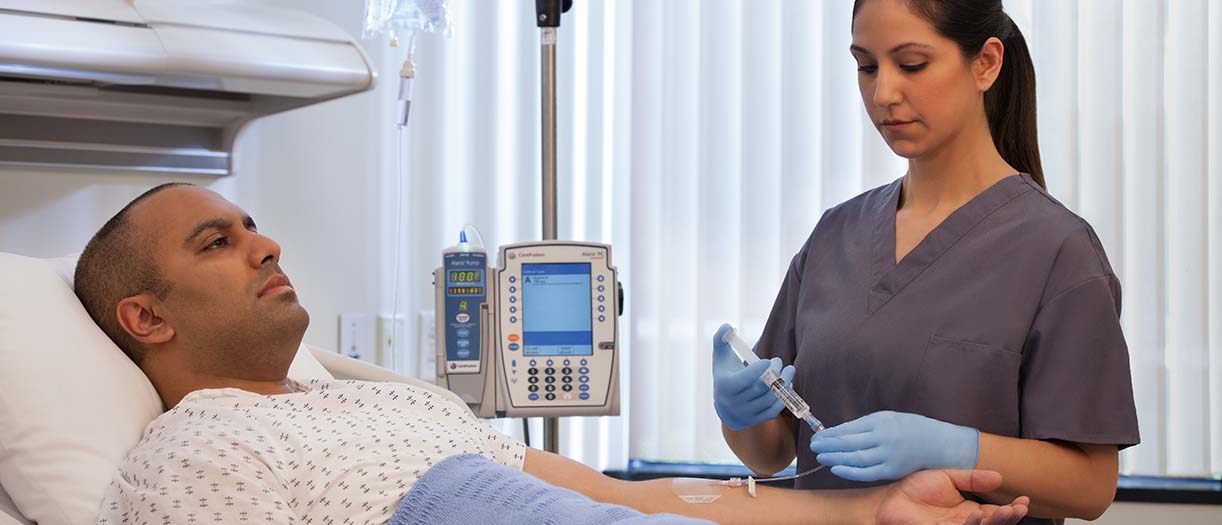Peripheral venous catheters: Cost impact of PVC care bundles
Despite being the most commonly used invasive medical device in hospitals, short-term peripheral venous catheters (PVCs) often fail before the end of treatment due to complications such as catheter occlusion, skin infiltration (diffusion), phlebitis, catheter dislodgement and infection.1,2
To understand how to better prevent catheter failure while promoting cost-effectiveness in the hospital, the Maunoury et al. Study, published in February 2022 in the Plos One journal, performs a cost-effectiveness analysis on two different approaches to peripheral venous access in the prevention of unscheduled PVC removal due to complications in France based on the CLEAN-3 study database:3
- The PVC care bundle method: consisting of a bundle of innovative devices, including a closed integrated PVC, a positive displacement needle-free connector, a disinfecting cap and a sterile pre-filled flush syringe.
- The standard method: consisting of a safety peripheral venous catheter to which the infusion line was directly connected, including a three-way stop cock.
Learn more about vascular access bundles: Care bundles and prevention of vascular access complications
The CLEAN-3 clinical study and the benefits of PVC care bundles
Published in February 2021 in the Lancet Infectious Diseases journal, the CLEAN-3 study followed a large panel of adult patients in the emergency department of Poitiers University Hospital in France with an indication of hospitalisation in a medical ward and a PVC of a predicted duration of at least 48 hours were included in the study.3 Following PVC insertion using one of the two study methods, they were monitored daily for catheter-related complications.3
When compared to the standard method, the CLEAN-3 study showed that the use of the PVC care bundle method made it possible to:3
- Reduce the frequency of occurrence of a complication requiring catheter replacement (e.g., phlebitis, diffusion, occlusion, local infection, dislodgement)
- Delay the time of occurrence of these complications
- Reduce the relative risk of PVC failure by 27%
The study also compared two skin preparation methods prior to PVC insertion and found a 92% reduction risk of infectious complications (catheter colonisation and local infection) with the innovative method chlorhexidine (CHG) when compared to 70% isopropanol (IPA) sterile single-use applicators and standard 5% povidone iodine (PVI), 69% ethanol solution with gauzes.3
Learn more about skin preparation and infection prevention: Achieving infection prevention and control—The Portuguese Experience
The cost effectiveness analysis of PVC care bundles following the CLEAN-3 results
Maunoury et al. state that although the PVC care bundle method is slightly more expensive for insertion and per day of use, the standard method requires more frequent and earlier removal of a defective catheter and its replacement, generating an additional expense.4 As well, treatment of catheter complications come with their own extra costs.4
The Maunoury et al. study concludes that the bundled devices (BDs) passed the test for cost-effectiveness within a conservative scenario.4
The BDs strategy is significantly more effective to prevent PVC-related complications and, therefore, unscheduled PVC removal, when compared to the standard devices approach (SDs), with significant savings for the hospital.4
Learn more about the Maunoury et al. study and PVC care bundles: Read the full study
References
- Rickard CM, Marsh N, Webster J, et al. Dressings and securements for the prevention of peripheral intravenous catheter failure in adults (SAVE): a pragmatic, randomised controlled, superiority trial. The Lancet. 2018; 392(10145):419–30. https://doi.org/10.1016/S0140-6736(18)31380-1
- Helm RE, Klausner JD, Klemperer JD, Flint LM, Huang E. Accepted but Unacceptable: Peripheral IV Catheter Failure. J Infus Nurs. 2015; 38(3):189–203. https://doi.org/10.1097/NAN.0000000000000100
- Guenezan J, Marjanovic N, Drugeon B, et al. Chlorhexidine plus alcohol versus povidone iodine plus alcohol, combined or not with innovative devices, for prevention of short-term peripheral venous catheter infection and failure (CLEAN 3 study): an investigator-initiated, open-label, single centre, randomised-controlled, two-by-two factorial trial. Lancet Infect Dis. 2021;21(7):1038–48. doi: 10.1016/S1473-3099(20)30738-6.
- Maunoury F, Drugeon B, Boisson M, et al. Cost-effectiveness analysis of bundled innovative devices versus standard approach in the prevention of unscheduled peripheral venous catheters removal due to complications in France. PLoS One. 2022 Jun 14;17(6):e0269750. https://doi.org/10.1371/journal.pone.0269750
BD-71061




